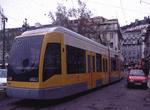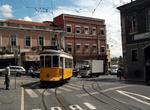Lisbon, Portugal
![]()
Lisbon tram on the Circuito das Colinas (Tourist Route) at Calçada de S. Francisco. Photo by David Pirmann, October 2001.
Trams
Lisbon has five tram lines serving the hilly neighborhoods of Alfama, Barrio Alto, etc. surrounding and crossing the city center (Baixa). Four of the lines (12, 18, 25, 28) are operated fairly infrequently with old Brill single truck trams built 1936-40.
The no. 15 tram line operates from the downtown square Praça da Figueira, through Praça do Comercio, then out to Belém and Algés to the west along the Tagus River waterfront. Along the way it passes the tram depot at Santo Amaro. This line is operated with modern low floor articulated trams built by Siemens in 1995, which are 24 meters long and carry 210 passengers. The cars are single-ended with doors only on the right side. Some of the service is supplied by the vintage single-truck trams.
A tramway museum is operated by the transit company, Carris, in the shadow of the Ponte de 25 Abril bridge (a suspension bridge modeled after the Golden Gate Bridge, with the addition of a lower deck for a rail line). The collection includes many preserved Lisbon trams-- however, the ones operating are just as old as those in the museum collection! The museum is located at the Santo Amaro tram depot.
A tourist tram is operated from Baixa district starting at Praça do Comercio along portions of all of the tram lines along with a guide narrating the sights. This ride takes about two hours, non stop, depending on the amount of cars and other obstacles parked on the tracks! The ride cost approximately $15 in 2001. For the budget minded the best of the tram rides would be the no. 28 which traverses the most interesting portion of the tram system for the cost of a regular fare.
- Route 12: Circular route serving Alfama district via Praça da Figueira, Martim Moniz, S. Tomé.
- Route 15: Praça da Figueira to Algés via Santo Amaro
- Route 18: Rua da Alfândega to Ajuda via Santo Amaro
- Route 25: Rua da Alfândega to Prazeres
- Route 28: Martim Moniz to Prazeres via Alfama district
Funiculars
Lisbon has three operating cable hauled funiculars ("elevadors"). First off and easiest to find from the main tourist district is the Gloria funicular, running from Praca do Restoradores up to the Barrio Alto. The right of way is an active street with car traffic (although mostly for access to parking areas).
Another funcular runs along the Rua de Bica, from the Rua de Sao Paolo at the bottom up to the Rua Loreto. This one is the hardest to find of the three funiculars but is the most interesting. The Bica's bottom terminal is inside a building and the top terminal is down a few steps preventing car access to the street at these points. However, the right of way is a street, which cars may access from a couple of
intersecting streets.
The third funicular is the Lavra, running up a hill west of Praca do Restoradores also along a pedestrian street.
Metro
The Lisbon Metro is a relatively small system (four lines with 40 stations). In 2001, the tickets cost 90 Portuguese escudos each in packs of 10 (even cheaper than Madrid at 40 cents each if my math is right). The trains are "wide", left hand running. Some of the trains have the rubber pass-thru joints between the cars. All of the lines (confusingly identified by colors-- red, blue, green, yellow; symbols, and line numbers) are all underground, except the Green/Yellow line's current northern terminal at Campo Grande. The elevated station is mostly to provide easier access to the yards which are at this location. The underground stations are pretty much uninteresting- all side platforms mostly with no walls between the tracks; very plainly decorated, not brightly lit, and many long passages to various entry stairways on the surface made them slightly threatening at late hours. There is also a short surface running stretch on the newest (Red) line but no above ground stations.
There is construction going on to extend ALL the lines at least 15 additional stations. The red line is the newest built for the 1998 Expo. This line has some surface running north of Olaias station and very beautiful stations; Olaias station is probably the most beautiful metro station I've ever seen.
 "
"
The lines of the Lisbon Metro. Click to enlarge. This map is licensed under Creative Commons Attribution 2.5 License. In short: you are free to distribute and modify the file as long as you attribute its author(s) or licensor(s). Source: WikiPedia.
MetroSul
MetroSul is a light rail line operating on the south side of the Tagus River.
Photo Gallery
| Five Random Images | ||||
 Image 8390 (105k, 820x556) Photo by: Theo Neutelings Location: Praça da Figueira |  Image 8484 (87k, 820x574) Photo by: Theo Neutelings Location: Praça do Comércio |  Image 33909 (189k, 1044x701) Photo by: David Pirmann Location: Alcântara |  Image 33951 (168k, 1044x701) Photo by: David Pirmann Location: Praça da Figueira |  Image 62626 (283k, 1044x646) Photo by: Thierry Leleu Location: Praça do Comércio |
Page Credits
By David Pirmann.